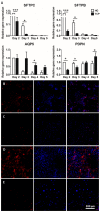Lung Extracellular Matrix Hydrogels Enhance Preservation of Type II Phenotype in Primary Alveolar Epithelial Cells
- PMID: 35563279
- PMCID: PMC9100165
- DOI: 10.3390/ijms23094888
Lung Extracellular Matrix Hydrogels Enhance Preservation of Type II Phenotype in Primary Alveolar Epithelial Cells
Abstract
One of the main limitations of in vitro studies on lung diseases is the difficulty of maintaining the type II phenotype of alveolar epithelial cells in culture. This fact has previously been related to the translocation of the mechanosensing Yes-associated protein (YAP) to the nuclei and Rho signaling pathway. In this work, we aimed to culture and subculture primary alveolar type II cells on extracellular matrix lung-derived hydrogels to assess their suitability for phenotype maintenance. Cells cultured on lung hydrogels formed monolayers and maintained type II phenotype for a longer time as compared with those conventionally cultured. Interestingly, cells successfully grew when they were subsequently cultured on a dish. Moreover, cells cultured on a plate showed the active form of the YAP protein and the formation of stress fibers and focal adhesions. The results of chemically inhibiting the Rho pathway strongly suggest that this is one of the mechanisms by which the hydrogel promotes type II phenotype maintenance. These results regarding protein expression strongly suggest that the chemical and biophysical properties of the hydrogel have a considerable impact on the transition from ATII to ATI phenotypes. In conclusion, culturing primary alveolar epithelial cells on lung ECM-derived hydrogels may facilitate the prolonged culturing of these cells, and thus help in the research on lung diseases.
Keywords: YAP; alveolar cells; extracellular matrix; hydrogels; type II phenotype.
Conflict of interest statement
The authors declare no conflict of interest.
Figures






Similar articles
-
In vitro model alveoli from photodegradable microsphere templates.Biomater Sci. 2015 Jun;3(6):821-32. doi: 10.1039/c5bm00034c. Epub 2015 Mar 27. Biomater Sci. 2015. PMID: 26221842 Free PMC article.
-
Human alveolar hydrogels promote morphological and transcriptional differentiation in iPSC-derived alveolar type 2 epithelial cells.Sci Rep. 2023 Jul 25;13(1):12057. doi: 10.1038/s41598-023-37685-x. Sci Rep. 2023. PMID: 37491483 Free PMC article.
-
Enolase 1 (ENO1) and protein disulfide-isomerase associated 3 (PDIA3) regulate Wnt/β-catenin-driven trans-differentiation of murine alveolar epithelial cells.Dis Model Mech. 2015 Aug 1;8(8):877-90. doi: 10.1242/dmm.019117. Epub 2015 May 14. Dis Model Mech. 2015. PMID: 26035385 Free PMC article.
-
Breaking the in vitro alveolar type II cell proliferation barrier while retaining ion transport properties.Am J Respir Cell Mol Biol. 2014 Apr;50(4):767-76. doi: 10.1165/rcmb.2013-0071OC. Am J Respir Cell Mol Biol. 2014. PMID: 24191670 Free PMC article.
-
IL-23 amplifies the epithelial-mesenchymal transition of mechanically conditioned alveolar epithelial cells in rheumatoid arthritis-associated interstitial lung disease through mTOR/S6 signaling.Am J Physiol Lung Cell Mol Physiol. 2021 Dec 1;321(6):L1006-L1022. doi: 10.1152/ajplung.00292.2021. Epub 2021 Sep 29. Am J Physiol Lung Cell Mol Physiol. 2021. PMID: 34585990
Cited by
-
Development of a physiomimetic model of acute respiratory distress syndrome by using ECM hydrogels and organ-on-a-chip devices.Front Pharmacol. 2022 Sep 2;13:945134. doi: 10.3389/fphar.2022.945134. eCollection 2022. Front Pharmacol. 2022. PMID: 36188621 Free PMC article.
-
Lung Extracellular Matrix Hydrogels-Derived Vesicles Contribute to Epithelial Lung Repair.Polymers (Basel). 2022 Nov 14;14(22):4907. doi: 10.3390/polym14224907. Polymers (Basel). 2022. PMID: 36433034 Free PMC article.
-
Innovative three-dimensional models for understanding mechanisms underlying lung diseases: powerful tools for translational research.Eur Respir Rev. 2023 Jul 26;32(169):230042. doi: 10.1183/16000617.0042-2023. Print 2023 Sep 30. Eur Respir Rev. 2023. PMID: 37495250 Free PMC article. Review.
-
Current possibilities and future opportunities provided by three-dimensional lung ECM-derived hydrogels.Front Pharmacol. 2023 Mar 9;14:1154193. doi: 10.3389/fphar.2023.1154193. eCollection 2023. Front Pharmacol. 2023. PMID: 36969853 Free PMC article.
-
In Vitro Models of Tissue and Organ Regeneration.Int J Mol Sci. 2023 Sep 26;24(19):14592. doi: 10.3390/ijms241914592. Int J Mol Sci. 2023. PMID: 37834040 Free PMC article.
References
-
- Bove P.F., Dang H., Cheluvaraju C., Jones L.C., Liu X., O’Neal W.K., Randell S.H., Schlegel R., Boucher R.C. Breaking the in vitro alveolar type II cell proliferation barrier while retaining ion transport properties. Am. J. Respir. Cell Mol. Biol. 2014;50:767–776. doi: 10.1165/rcmb.2013-0071OC. - DOI - PMC - PubMed
MeSH terms
Substances
Grants and funding
- SAF2017-85574-R/Ministerio de Ciencia, Innovación y Universidades, Spain
- DPI2017-83721-P/Ministerio de Ciencia, Innovación y Universidades, Spain
- PID2019-108958RB-I00/Ministerio de Ciencia, Innovación y Universidades, Spain
- PGC2018-097323-A-I00/Ministerio de Ciencia, Innovación y Universidades, Spain
- 821772/European Union's Horizon 2020, Marie Sklodowska-Curie
LinkOut - more resources
Full Text Sources
Medical

